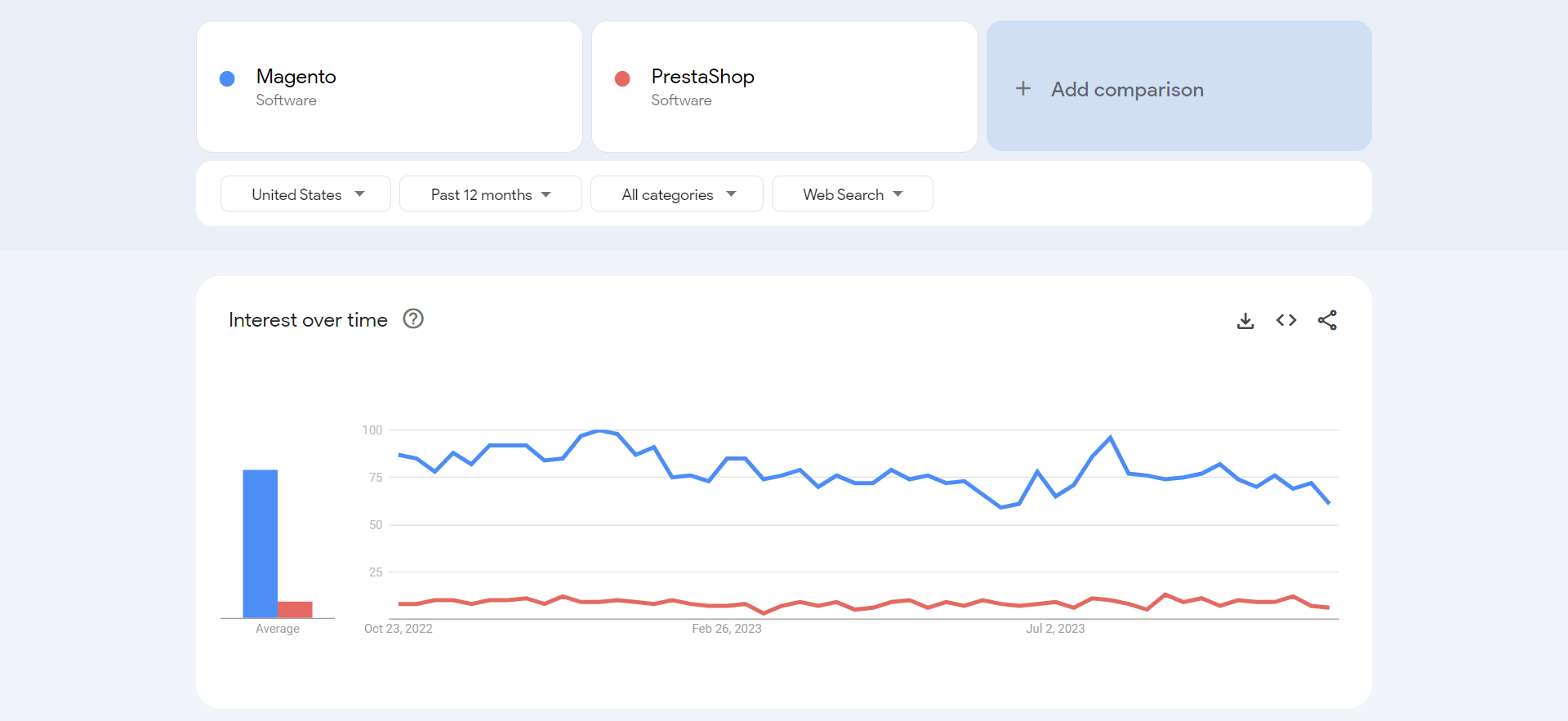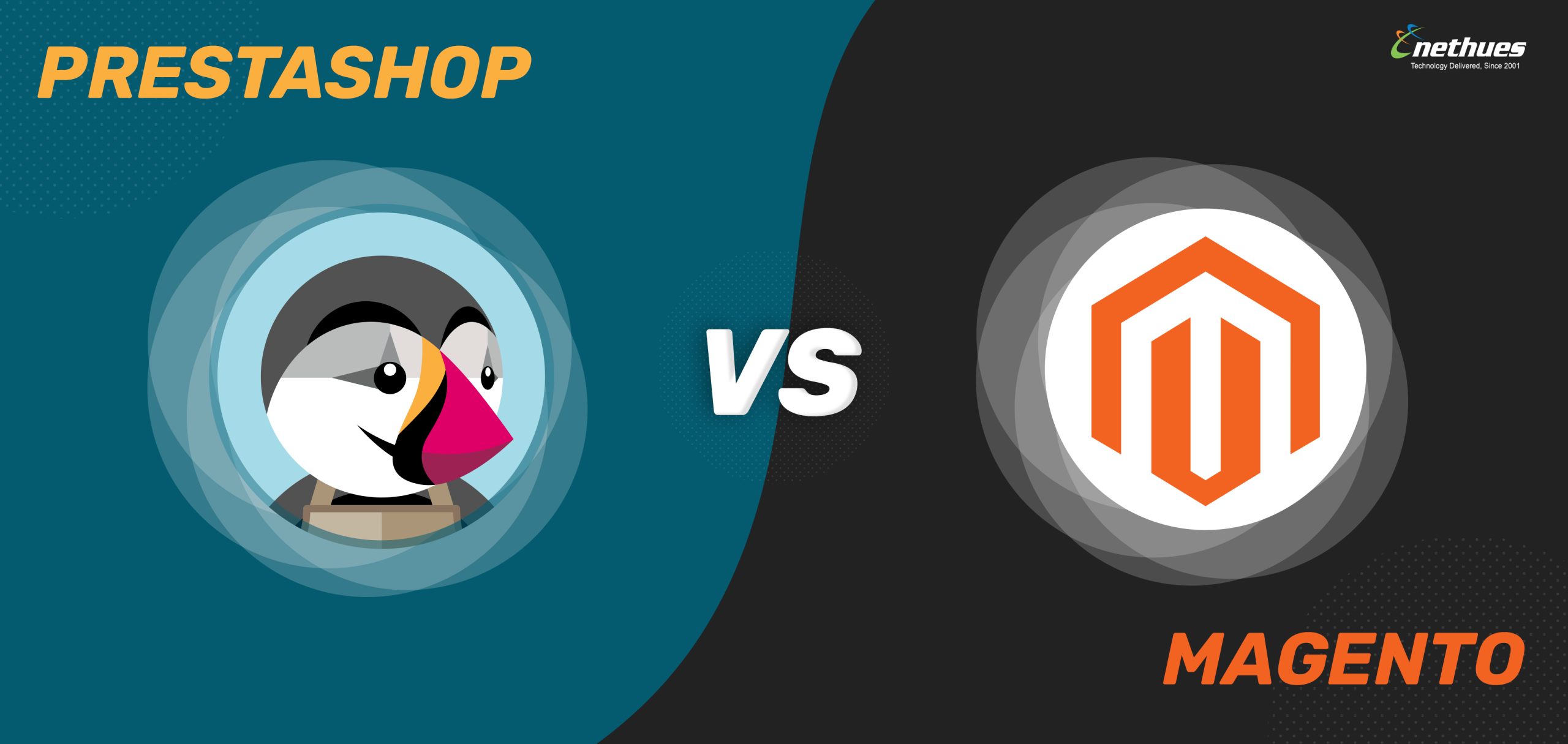The world of eCommerce is vast and brimming with choices. Selecting the ideal platform for your store can prove challenging, especially if you lack familiarity with its functionality. Two of the most prominent names in the tech space are PrestaShop and Magento. Both have unique offerings of their own.
In this blog, we have conducted an in-depth comparison of Magento vs Prestashop. We’ll also delve into various factors to help you make an informed decision.
Let’s discuss Magento vs PrestaShop! If you’re seeking expert guidance for your eCommerce venture, consider reaching out to a reliable Ecommerce development company to ensure a seamless and successful implementation
What is Magento?
 Magento is a renowned platform for building visually appealing online stores with advanced capabilities. It is available in open-source and paid versions, making it a top enterprise-class eCommerce platform. The platform offers powerful marketing tools, search engine optimization, and catalog management tools. It gives Magento users total control over the store’s appearance, content, and functionality.
Magento is a renowned platform for building visually appealing online stores with advanced capabilities. It is available in open-source and paid versions, making it a top enterprise-class eCommerce platform. The platform offers powerful marketing tools, search engine optimization, and catalog management tools. It gives Magento users total control over the store’s appearance, content, and functionality.
What is PrestaShop?
 PrestaShop is an advanced eCommerce platform designed to meet global trade demands while remaining user-friendly. This open-source platform provides a premium business model for businesses seeking to establish online stores. Hosting an impressive range of features, PrestaShop is particularly favored by small to medium-sized enterprises.
PrestaShop is an advanced eCommerce platform designed to meet global trade demands while remaining user-friendly. This open-source platform provides a premium business model for businesses seeking to establish online stores. Hosting an impressive range of features, PrestaShop is particularly favored by small to medium-sized enterprises.
Comparison between Magento vs PrestaShop
According to Google Trends, Magento has emerged as the market leader when compared to Prestashop. However, here are various factors to evaluate for a thorough comparison.

Ease of Use
Installing Magento and setting up a shop manually can be a challenging task, particularly for non-technical users. To simplify the process, one may hire a Magento developer or seek assistance from a Magento web development agency.
On the other hand, customizing a PrestaShop is comparatively less complex. Additionally, installing a PrestaShop website is more straightforward. However, it is still suggested to Hire a PrestaShop developer for the installation process. It has simplified management that enables users to operate it effortlessly. Consequently, PrestaShop is a more user-friendly option compared to Magento.
Extensions
The integration of extensions into online stores can significantly enhance the performance of eCommerce websites. Both PrestaShop and Magento provide the option to add and personalize functionalities to your store. Magento, in particular, offers a wide array of paid and free extensions that cater to complex stores. With over 5000+ Magento extensions, it provides benefits such as improved customer experience and increased sales.
On the other hand, PrestaShop provides approximately 10,000 themes, graphics, and modules that can be effortlessly incorporated in just a few clicks. These modules are ideal for beginner-level users and serve to support the eCommerce business. Additionally, they allow store owners to seamlessly integrate other eCommerce products into their stores.
Also Read – How to Find a Magento Developer
Built-in Features
With a host of built-in features, Magento provides a comprehensive eCommerce solution. It enables businesses to generate analytics and sales reports, optimize their mobile storefront, and access advanced functionalities such as Page Builder, GraphQL, and Live Search. Upgrading to the latest Magento version is strongly recommended to enhance the performance and security of their online stores.
While PrestaShop Development also offers a range of essential functions for managing an eCommerce store, Magento Commerce Edition is equipped with even more advanced features, providing businesses with a powerful platform for success.
Security
It’s important to dedicate ample time to ensuring your store’s and customers’ safety. eCommerce platforms like Magento prioritize security and regularly issue patches every few days. These patches improve store performance and user experience, while third-party tools and Magento security extensions offer additional security checks. Magento security patches evolve with each new version, and its overall security is considered unparalleled.
Meanwhile, PrestaShop offers a PCI-compliant setup file, and merchants prefer hosting their sites on this platform for added security. Both eCommerce platforms prioritize customer safety by implementing standard security measures and minimizing risk. In comparison, Magento’s wealth of features, security tools, and plugins make it the superior choice for security-conscious businesses.

SEO Capabilities and Marketing
Both Magento and PrestaShop are equipped with multiple SEO optimization features. These include modifying URLs, adding canonical tags, implementing redirects, and more.
Magento, in particular, offers an out-of-the-box SEO solution with a range of default functionalities. This powerful platform enhances search engine rankings and provides options for managing promotions, communication, and content.
Similarly, PrestaShop also provides default SEO features that can help improve your store’s rankings and drive more traffic. With these powerful capabilities, both eCommerce platforms are ideal for businesses looking to enhance online visibility and attract more customers.
Themes
The design of your online store is heavily influenced by the themes you choose. Extensions and plugins can be incorporated to add unique functionalities to the store. Rather than starting from scratch, both eCommerce platforms offer pre-made themes that can be purchased.
The Magento theme directory has very limited themes available. Themes in Magento 2 offer consistent designs and styles, with premium options available on sites like ThemeForest and TemplateMonster. PrestaShop, on the other hand, offers over 3200 ready-made themes, with third-party options also available. A demo of these PrestaShop Templates is also available. Since both platforms are open-source, users can customize and modify themes to fit their brand and create a unique website design.
Support
As open-source eCommerce platforms, Magento and PrestaShop provide support primarily through documentation and online communities. Both platforms have a large user base willing to offer assistance in case of any issues. However, due to its significantly larger community, Magento Marketplace has more support resources for users, including detailed guides and official support through paid plans.
PrestaShop platform, on the other hand, does not have a dedicated support team. They do offer paid PrestaShop support plans for those who require assistance. It is, therefore, advisable to hire a dedicated PrestaShop developer to ensure consistent and reliable support.
Also Read – Magento eCommerce Optimization: 7 Tips to Enhance Performance in 2023-24
Payment Methods
Both Magento and PrestaShop have robust payment processing systems that enable customers to choose from multiple payment options. While Magento provides default payment methods like PayPal and Braintree, additional payment methods can be integrated through Magento 2 at an additional cost.
Similarly, PrestaShop supports numerous payment methods, including cheques, cash on delivery, and PayPal. PrestaShop users can install other payment gateways using modules such as the PrestaShop Checkout Solution.
Conclusion
When it comes to setting up an online shop, there are numerous eCommerce platforms to choose from. However, after careful consideration, it becomes clear that PrestaShop and Magento are two of the top contenders. While Magento is ideal for running a large-scale eCommerce operation, PrestaShop stands out for its ease of use. If you are starting a new online shop, PrestaShop may be the best option for you. However, Magento is the preferred choice if you require more advanced features.
No matter your business size, our team of expert developers can assist you in choosing the best fit for your eCommerce site. Get in touch with us today.







